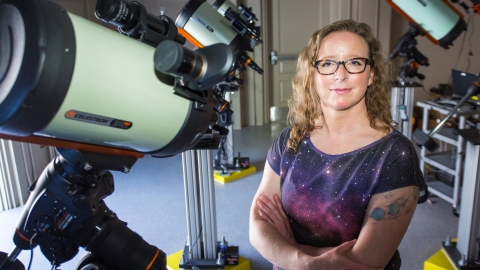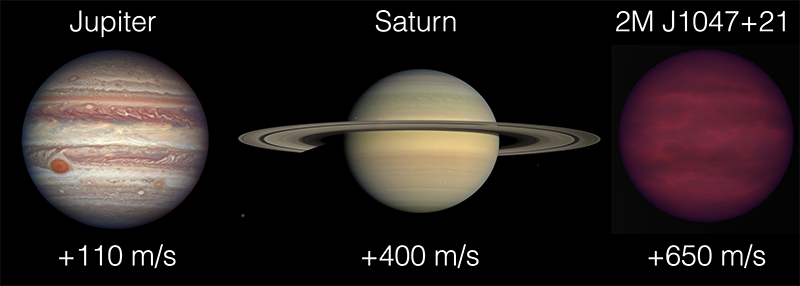
Allers Develops New Technique to Measure Wind Speed Outside Solar System
April 9, 2020
Katelyn Allers stands among the telescopes at the Bucknell Observatory. Photo by Brett Simpson, Communications
Bucknell University Professor Katelyn Allers, physics & astronomy, is publishing the first measurement of atmospheric wind speed outside the solar system using a new technique she developed. Her study, "A Measurement of the Wind Speed on a Brown Dwarf," will be published Friday, April 10, by Science, one of the world's top academic journals.
Allers conducted the research using NASA's recently decommissioned Spitzer Space Telescope and the Karl G. Jansky Very Large Array with collaborators Johanna Vos, a postdoctoral research fellow at the American Museum of Natural History; Beth Biller, a Chancellor's Fellow at the Institute for Astronomy, part of the School of Physics and Astronomy at the University of Edinburgh; and Peter K. G. Williams, innovation scientist for the Center for Astrophysics and the American Astronomical Society.
The researchers measured a wind speed of 650 meters per second (1,450 miles per hour) for a cool brown dwarf — an object in space occupying the mass range between the heaviest gas giant planets and the lightest stars. The brown dwarf they studied (2MASS J1047+21) is 33.2 light years from earth.
The study describes a new technique for measuring wind speed that can be more broadly applied to exoplanets — planets orbiting other stars — and brown dwarfs.
"This is the first time the method we used to do this has been attempted," Allers says. "The idea is similar to how winds could be measured for Earth, but in terms of things that you could determine from afar.
"On Earth, for example, say you have a cloud being blown by some wind," she says. "If you're looking down at Earth from space, you could measure the speed of a continent as it rotates in and out of view and a different speed for the cloud as it rotates in out of view. And that difference in speed occurs because wind has pushed that cloud relative to the surface."
For planets and brown dwarfs outside of our solar system, Allers reports "we can't see the clouds themselves, but when a cloud rotates into view or out of view, it changes the brightness of the planet." With that in mind, she monitored the brightness of 2MASS J1047+21 and used periodic changes in its brightness to determine the rate at which the atmosphere is rotating.

This image compares the wind speed measured on the brown dwarf to the gas giant planets in our solar system. Image courtesy of NASA and R. Hurt, IPAC
The Spitzer Space Telescope was central to detecting the rotating atmosphere of the brown dwarf.
"Brown dwarfs are relatively cold and emit most of their light in the infrared range," Allers says. "The Spitzer Space Telescope's ability to observe at infrared wavelengths was perfect for this work."
Because researchers can't observe landmasses on objects outside of the solar system, they relied on observations at radio wavelengths to look at the rotation below the atmosphere. The radio data measured the rotation of a planet's magnetic field.
"Since the magnetic field originates deep in the planet, or in this case brown dwarf, the radio data allows us to determine the interior period of rotation," Allers says. "When you have an interior rotation rate and an atmospheric rotation rate, you can compare them to see how fast the wind is blowing."
She said that the team's new technique should also allow future researchers to better understand the physics of the atmospheres outside of the solar system.

